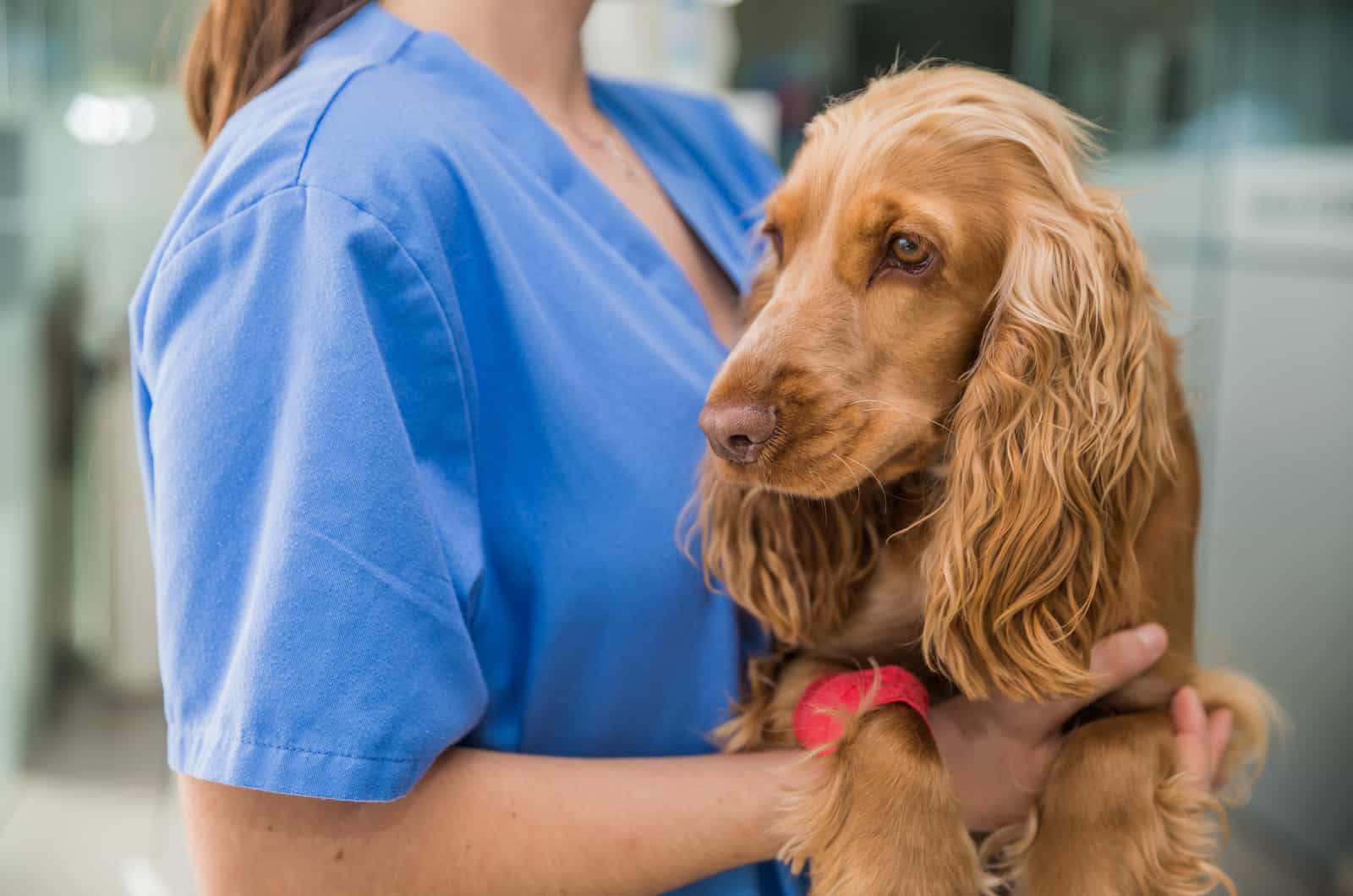Welcome, all female dog owners who have heard of dog progesterone levels but are not quite sure what they mean. To put it simply, dog progesterone is a hormone produced by the adrenal cortex and ovaries. It is one of the most crucial female dog hormones that play a key role in reproduction. Besides estrogen and luteinizing hormone (LH), progesterone regulates the heat cycle and pregnancy of female dogs.
Some veterinarians like to call progesterone “the guardian of pregnancy” because its levels are essential for the normal development of puppy fetuses and the prevention of early uterine contractions in pregnant dogs.
This is why using a dog progesterone levels chart will help breeders and dog owners figure out the time of the heat cycle (ovulation), as well as help them monitor the dog’s pregnancy.
We have put up a dog progesterone levels chart that not only shows progesterone levels but also answers the most frequently asked questions when it comes to female dogs’ reproductive tract and health.
Dog Progesterone Levels Chart Overview

For the most part, owners and breeders pay attention to female dogs’ progesterone levels when they want to develop new puppies. In short, different female dog progesterone levels mean different likelihoods of becoming pregnant.
When progesterone levels are too high, there is little to no chance that the female dog will conceive. On the other hand, when progesterone levels are too low, it is too early to determine ovulation, let alone the estimated timeframe for breeding.
This dog progesterone levels chart shows different progesterone concentrations in female dogs and the optimum time of breeding.
[table id=555 /]
This dog progesterone levels chart is created by the IDEXX Laboratories, a company that issues progesterone tests and instructions on how to properly measure progesterone levels.
This chart is for female dogs in heat that are to be bred, and for female dogs that are not going through the fertile period.
Other dog progesterone levels charts may show progesterone levels in nmol/L, rather than ng/mL.
What Are The Most Common Progesterone Levels In Dogs?
When measuring the progesterone levels in female dogs, breeders should pay attention to ovulation timing.
Progesterone level rise and fall are time limited which means that breeders have to choose the right time to breed their female dog. That time limit can be as little as 48 hours, depending on the ovulation cycle.
The fertile period in female dogs marks an incredible progesterone rise. In the majority of cases, progesterone levels of fertile female dogs during the fertile window rise above 20 ng/mL.
Another “most common progesterone level” in dogs is 5 ng/mL which indicates ovulation and the optimal time for natural breeding.
What Level Of Progesterone Do Dogs Ovulate?

Let’s take a look back at our dog progesterone levels chart overview.
The progesterone level ranges between 4 and 8 ng/mL indicating that female dogs are ovulating. The baseline serum progesterone of 2.5 ng/mL indicates that it is time to monitor the female dog because she will start ovulating soon.
At a progesterone level of 5 ng/mL, the female dog is ovulating. Female dog ovulation and progesterone level increase following an initial rise of the luteinizing hormone (LH peak).
Female dog ovulation happens when progesterone results show a slight increase in comparison to estrogen levels that decrease. Both estrogen and LH fall as the progesterone levels keep rising.
When we are estimating the “optimal time” to breed a female dog, we must look at all reproductive female hormones. Progesterone alone can not determine whether or not the female dog is ready to mate.
What Is The Best Progesterone Level?

While there is no “best progesterone level” in female dogs, there is an “optimal progesterone value” which is considered to be the best time for mating.
So the optimal progesterone value for a female dog is between 5 to 10 ng/mL and above.
To find out the progesterone value of an intact female dog, breeders must monitor the whole estrous cycle — from the first day to the last. In other words, breeders should look for drastic changes in female dogs’ behavior such as restlessness, frequent urination, running away, or having low energy levels.
Another way you can tell that your female dog is in heat is by observing male dogs in her vicinity that show signs that they want to mate.
Be on the lookout for a female dog’s vaginal discharge which is the most obvious sign that a female dog is in heat.
How Quickly Does A Dog’s Progesterone Rise?
It takes quite some time for progesterone levels to start rising in female dogs. But, once ovulation happens, the progesterone rise becomes rapid.
Female dog ovulation normally lasts between two to three days, but it can vary depending on the age and health status. During this period, progesterone values rise between 4 and 8 ng/mL.
The post-ovulation period is better known as the fertile period which lasts three to four days. This is the period when progesterone rises rapidly.
Progesterone levels begin to rise at the time of the LH surge and are in the 4-8 ng/mL range by the time the female dog ovulates.
Two to three weeks after the female dog’s ovulation period serum progesterone concentrations reach between 10 and 80 ng/mL.
These progesterone values in the female dog will remain at this level for about 60 days regardless of whether the dog is bred or showing signs of pregnancy.
What Causes A Dog’s Progesterone Level To Go Up?

The progesterone rise in female dogs is part of a healthy estrus cycle, but it can indicate a few other things. Regardless of whether the female dog is pregnant or not, the normal range of progesterone value is between 10 and 90 ng/mL.
Progesterone levels in female dogs can be higher than normal which can be due to the:
• Pregnancy with multiple puppies
• Ovarian cysts
• Ovarian cancer
• Disorder of the adrenal glands
During progesterone rise in dogs, the estrogen levels begin to fall. Progesterone rising brings along a few symptoms that may be noticed in female dogs.
What Are Symptoms Of Progesterone Rising In Dogs?
Symptoms of progesterone rising in female dogs can be mild and almost unnoticeable. The female dog whose progesterone levels are rising shows signs of vulvar swelling, and breast enlargement/tenderness.
Some female dogs experience cramps but this is not the most common sign of progesterone rise.
Low appetite in addition to behavioral changes such as aggression, lethargy, and anxiety is recorded in female dogs with progesterone rise.
However, each female dog is unique, so progesterone rise signs can vary.
What Does It Mean When Progesterone Levels Fall?

Progesterone levels decrease which is a natural part of a female dog’s estrous cycle. At about 48 hours before whelping, progesterone values fall to 2 ng/mL.
24 hours before whelping, progesterone levels fall to 1 ng/mL which may be considered too low, but it is completely normal in this case.
When progesterone levels fall under 2 ng/mL, then this is a sign a female dog is going into labor soon.
If progesterone levels are lower than normal, it may mean that your female dog:
• Is not ovulating normally
• Had a miscarriage
• Has fertility problems
• Lack of luteinizing hormone (LH)
• Interrupted pregnancy
Physiologically low progesterone levels are great for determining the optimal timing of a c-section and whelping.
When progesterone levels are constantly low, then the female dog should be taken to the veterinarian to determine if there are any issues concerning her reproductive tract.
What Are Symptoms Of Low Progesterone In Dogs?
In contrast to progesterone rising symptoms, female dogs that experience low progesterone do not exhibit specific symptoms. Several symptoms can indicate low progesterone in female dogs; lethargy, inappetence, moodiness, and in some cases high fever.
Keep in mind that these symptoms are not specific to low progesterone values and they may indicate an underlying health condition.
When compared to progesterone rise which takes quite some time to happen, progesterone fall can happen within a few hours.
What Is The Progesterone Level For A Pregnant Dog?

To begin with, female dogs that are to be bred require progesterone levels that exceed 4 ng/mL. A female dog’s pregnancy can not be determined by progesterone levels.
However, pregnant female dogs should have progesterone value at baseline 2.6 ng/mL which assures normal fetus development.
A study on progesterone concentrations in pregnant dogs included a total of 126 female dogs of different dog breeds. Not all female dogs were pregnant — those in diestrus had their blood sample taken to measure serum progesterone concentration. Pregnant dogs had their serum progesterone measured during early, mid and late pregnancy.
This study showed that pregnant female dogs exhibit higher progesterone concentrations than non-pregnant ones.
What Should My Dog Progesterone Level Be To Breed?

The reason why breeders and owners measure progesterone values in their female dogs is to either find the optimal time for breeding or to predict parturition and whelping. Progesterone levels that indicate the optimal time for breeding depend on the breeding method.
The “golden rule” is to breed a female dog whose progesterone levels reach 5 ng/mL. But, that can vary depending on the stud dog’s semen.
Natural breeding is always a way to go, but some dog breeds like French Bulldogs require artificial insemination to become pregnant. In this case, veterinarians use fresh chilled semen or frozen semen from quality stud dogs to impregnate a female dog.
But, both breeders and veterinarians must pay attention to the female dog’s estrous cycle and progesterone levels to accurately estimate the optimal timing for breeding, c-section, or whelping.
Best Dog Progesterone Level For Natural Breeding
While many believe that the best progesterone level is at 5 ng/mL, we have to keep in mind that during this time, female dogs’ eggs are not matured yet.
At a progesterone level of 5 ng/mL, a female dog’s follicles are matured, but the eggs that are released are not yet ready to be fertilized by fresh chilled semen.
Natural mating can occur because a stud dog’s fresh semen can survive within the female dog’s reproductive tract for up to seven days until the oocytes (eggs) become mature enough for fertilization to occur.
This means that fresh stud dog’s semen can fertilize a mature female dog’s egg post-ovulation.
Best Dog Progesterone Level For Artificial Insemination
Artificial insemination is very different from natural breeding in dogs.
AI uses fresh chilled semen or frozen semen that is artificially inserted into the female dog’s reproductive tract.
In theory, fresh chilled semen can be used when progesterone levels of the female dogs reach 5 ng/mL, but it is recommended to wait at least 3 days after the 5 ng/mL progesterone value. As we have previously mentioned, this is the optimal time for natural breeding.
To proceed with artificial insemination, breeders have to wait until their female dog’s progesterone levels are at least 20 ng/mL (or more).
How Are Progesterone Tests Done For Dogs?

Progesterone tests for dogs show serum progesterone values that are measured by taking the dog’s blood sample and proceeding with progesterone laboratory tests.
Progesterone tests for dogs can not be done at home. So, it is required to contact a professional DVM to have the female dog progesterone tested.
Serum Progesterone Blood Tests
The majority of veterinary clinics have in-house progesterone testing machines that show results very quickly. In-house progesterone tests for progesterone level determination in female dogs use ELISA tests (semi-quantitative Enzyme-Linked Immunosorbent Assays).
These tests are to be done by professionals and they require a lot of delicate handling and good timing. Even though progesterone ELISA tests are relatively simple to perform and are done within 30 minutes, they might not be as accurate as laboratory tests.
Laboratory progesterone testing in female dogs takes more time, but the results are more specific and accurate. The progesterone values that we have mentioned in this article are measured in ng/mL which is the result of accurate laboratory progesterone testing.
Vaginal Cytology Tests
Another way to determine whether or not the female dog is in heat is by taking a vaginal smear and performing vaginal cytology. Vaginal cytology in female dogs focuses on physiological and pathological changes of epithelial cells.
This means that the vaginal smear can not show the hormonal status of the female dog, but it can be helpful to determine whether or not her reproductive tract is healthy.
Practically, vaginal cytology should be done alongside laboratory progesterone testing of female dogs.
When Should You Progesterone Test A Dog?

Now that we know when and how the progesterone levels rise and fall, the biggest question is “When should your progesterone test a dog?”
During proestrus, your female dog will show signs which include vulvar edema and bleeding. Keep an eye out for these signs because they will help you figure out the optimal timing for progesterone testing and give you insight into the estrus cycle.
Progesterone levels should be measured between day five and seven after you have noticed the previously mentioned signs of proestrus.
The progesterone test should be repeated every two or three days if the results are not favorable. Each time you progesterone test your female dog, make sure to save the results.
Conclusion
If you are still wondering why dog progesterone levels chart is a thing in the dog breeding world, then let me explain. Determining and regulating progesterone levels in female dogs is essential for:
• Monitor female dog’s estrus cycle
• Figure out the optimal time for breeding
• Predict parturition
• Schedule pregnant female dogs for C-section
• Anticipate whelping
The progesterone secretion pattern is unique for each female dog. So, don’t get discouraged if your female dog doesn’t show the same progesterone levels and ovulation timing. Even experienced dog breeders may struggle to choose the optimal time to mate their female dogs.
In any case, it is essential to consult a DVM for expert advice and additional tips.
Related Content
Dog Urine Color Chart: What Does My Dog’s Pee Color Mean?
Dog Tongue Color Chart: What Color Is A Sign Of A Healthy Dog?
